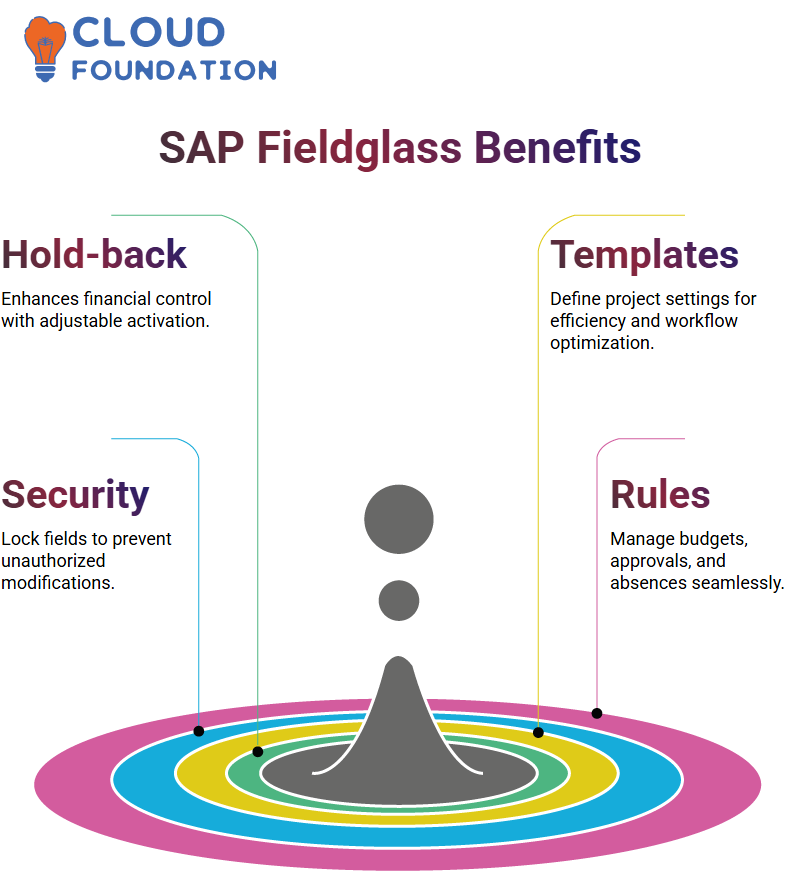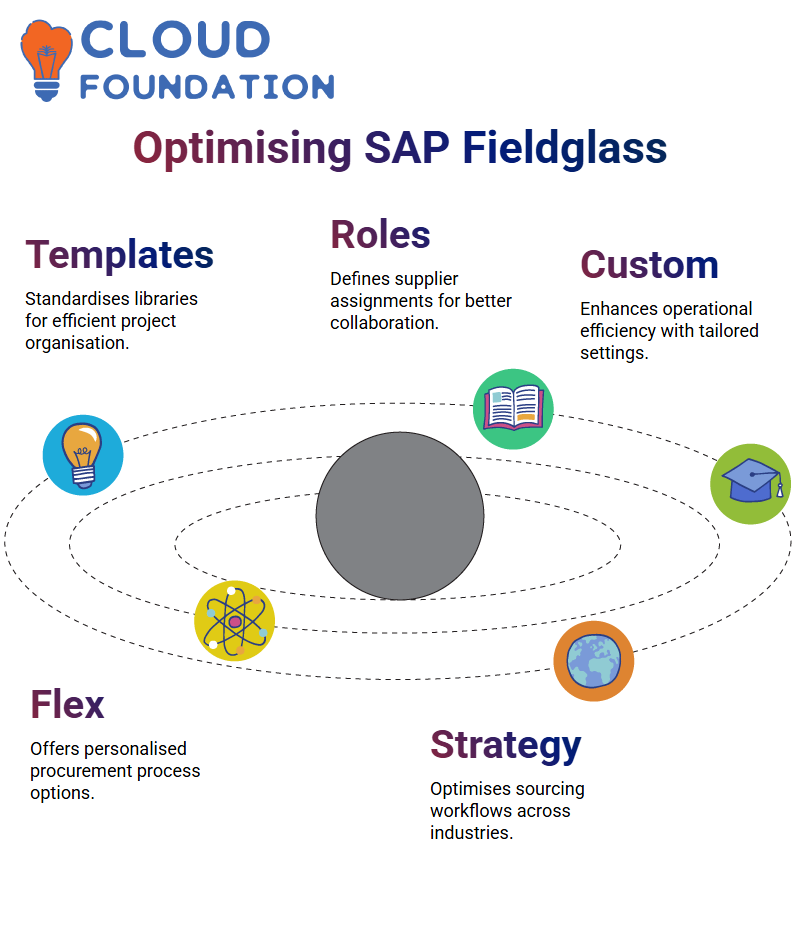How to Set Up User Roles and Permissions in SAP Fieldglass
SAP Fieldglass Features
SAP Fieldglass’ hold-back feature is also an invaluable asset, offering organisations greater financial control by allowing them to turn this feature on or off as needed.
While some organisations choose not to utilise this function at all, others leverage its benefits in their operations for enhanced financial management purposes.
Template configurations in SAP Fieldglass define how projects inherit characteristics from their master structures, from activating name locks to setting visibility parameters. Each setting enhances workflow efficiency and contributes to creating a more straightforward work process.
SAP Fieldglass enables buyers and suppliers to tailor classifications and accounting configurations to their specific business requirements, including budget revisions, maximum allocations, and SVW coordination. Budget changes must also be carefully planned out.

Rule settings within SAP Fieldglass play a crucial role in helping organisations efficiently manage budgets, absences, and approvals, creating a seamless procurement process without disruptions or hassle.
SAP Fieldglass’s ability to hide or lock fields ensures data remains securely managed, preventing unauthorised modifications from taking place. Businesses often tailor these settings to meet their operational and compliance needs.
SAP Fieldglass was designed for scalability, allowing companies to integrate their workforce management and financial tracking systems seamlessly. By understanding its functionality and using it effectively, businesses can enhance operational efficiency and foster improved collaboration with suppliers.
Working within hierarchical rules is crucial in optimising procurement processes, providing organisations with seamless supplier engagement. By harnessing its powerful capabilities, organisations can ensure smooth supplier relations.
Exploring Advanced Features of SAP Fieldglass
SAP Fieldglass provides users with an intuitive system for scheduling, managing events, and creating custom templates.
Based on company needs and goals, schedule management ensures the accurate execution of tasks and deadlines, while buyers can create event structures to match procurement policies, ensuring seamless alignment.
SAP Fieldglass features question libraries with built-in queries designed to streamline information gathering and retrieval, thereby streamlining documentation processes and supplier communications by ensuring all necessary details are accurately captured.
SAP Fieldglass Core Functions
SAP Fieldglass is an intuitive platform designed to streamline sourcing and procurement processes. As I explore its features, I notice various types with distinct characteristics; by selecting one type, I am then able to name and describe it. This description plays a crucial role in outlining the project scope in SAP Fieldglass.
SAP Fieldglass’s key strength lies in how information is dynamically populated according to your chosen type. For instance, when I select ‘Sourcing’ as my type, SAP automatically integrates relevant fields that describe its interactions with suppliers and stakeholders, as well as access levels, visibility restrictions, and modification permissions.
Supervisor Settings in SAP Fieldglass
Supervisors (often line managers) oversee various parts of the SAP Fieldglass workforce management system.
Companies determine how best to utilise this feature depending on their internal structure.

Even when supervisors aren’t explicitly assigned, contractors still report directly to one manager in SAP Fieldglass to ensure accountability when managing workforce administration.
SAP Fieldglass for Seamless Supplier Management
SAP Fieldglass is an efficient platform designed to simplify supplier management, giving buyers control over revisions and necessary changes.
SAP Fieldglass empowers buyers to control adjustments and ensures transparency between parties. Any supplier-defined parameters must align with the company’s policies to ensure smooth transactions.
SAP Fieldglass makes one of its hallmark features easy: suppliers’ ability to modify invoices within a predefined scope.
While suppliers can reduce amounts without further approval from management, increasing them requires explicit consent from management first. Many businesses prefer to lock this feature to prevent unexpected billing issues.
SAP Fieldglass enables suppliers to efficiently create multiple events from a single entry, streamlining service management across various locations and simplifying deliverables for both buyers and suppliers. As such, SAP Fieldglass becomes an indispensable tool.
Managing Templates and Libraries in SAP Fieldglass
SAP Fieldglass provides an organised approach for managing templates and libraries. Users can configure class libraries across regions or companies for standardised approaches.
Maintaining event libraries helps organise projects efficiently by clearly outlining rate codes or fee structures for projects.
SAP Fieldglass’s key feature for managing role-based supplier assignments is the ability to create roles.
 Assigning suppliers ensures smooth collaboration and procurement execution, creating an optimised sourcing workflow process in turn.
Assigning suppliers ensures smooth collaboration and procurement execution, creating an optimised sourcing workflow process in turn.
How SAP Fieldglass Adapts to Different Companies
SAP Fieldglass features an adaptable framework, allowing organisations of various kinds to tailor settings specifically to their requirements.
While core functionalities remain constant, companies can add custom elements to enhance operational efficiencies and effectiveness, making SAP Fieldglass a versatile solution across various industries.
Through flexible configuration options, SAP Fieldglass helps companies personalise their procurement processes while still adhering to essential workflows.
Understanding how SAP Fieldglass functions within different business environments helps users make informed decisions and optimise their sourcing strategies.
Integrating Employee Data with SAP Fieldglass
Where does user data come from? SAP Fieldglass retrieves employee records from HR databases such as Workday, SuccessFactors or ERP systems like Oracle EBS.
Some organisations manually maintain this data, while others integrate SAP Fieldglass with platforms like Workday or SuccessFactors for automatic maintenance of employee records in SAP Fieldglass.
SAP Fieldglass relies heavily on accurate employee data to function optimally.
Companies often opt to integrate HR systems for seamless data transfer or manually update records within the platform. Either way, precise employee details ensure efficient operations.
Working with Suppliers in SAP Fieldglass
SAP Fieldglass enables companies to manage contractors, external vendors, internal vendors, and independent contractors efficiently. SAP Fieldglass organises profiles within its system.
SAP Fieldglass distinguishes two categories of suppliers, transactional and non-transactional suppliers.
Transaction suppliers actively submit their time sheets and expenses, which undergo approval and payment processing.
Non-transaction suppliers, on the other hand, do not submit time sheets and expenses that require approval and processing before payment is processed.
Non-transaction suppliers do not interact with SAP Fieldglass in terms of financial transactions; their details exist solely for access and administrative purposes.
Managing Errors in SAP Fieldglass
Errors occur, but SAP Fieldglass offers a straightforward solution to address them. When an upload contains incorrect or missing data, SAP Fieldglass flags it and prevents submission.
To resolve errors with SAP Fieldglass, it’s necessary to study the logs, correct any issues, and reupload data until everything has been accurately uploaded into the system.

By adhering to best practices, we can ensure minimal mistakes when working with SAP Fieldglass.
SAP Fieldglass Users
SAP Fieldglass is a software-as-a-service solution designed to manage the external workforce and contingent labour.
Let’s first learn who users are within SAP Fieldglass: many may assume contractors; however, it is worth noting that “user” refers to employees of an organisation, rather than contractors.
Contractors are external workers employed by another company to perform services for its client companies.
For instance, if your firm provides product- or service-based organisation-focused services, then its employees would be considered contractors. When we refer to users in SAP Fieldglass, however, we mean employees of the client company.
User groups within SAP Fieldglass could include hiring managers, managed service providers (MSPs) or others involved in workforce administration.
MSPs from different companies often still gain access to SAP Fieldglass for specific uses.
User Roles in SAP Fieldglass
SAP Fieldglass prioritises efficient management of contractors, enabling businesses to easily and quickly create user roles and access permissions.
SAP Fieldglass offers various roles that define individuals’ interactions with its system, such as hiring managers overseeing the recruitment of external workers, while MSPs (Managed Service Providers) act as intermediaries, helping businesses manage their contingent workforce seamlessly.
SAP Fieldglass makes an essential distinction between birthright users and non-birthright users: employees can typically access their data via HR systems; external contractors and MSPs, on the other hand, require manual configuration of access within SAP Fieldglass.
Businesses establishing user roles within SAP Fieldglass must synchronise their permissions with those contained within their HR system for smooth access control and role management.

Connectors provide invaluable assistance during large-scale implementation projects.
User roles define the capabilities of individuals within SAP Fieldglass. From authorising work orders and supplier management to overseeing hiring processes and payroll administration, role-based access ensures efficient workflow management.
Furthermore, organisations have access to finely controlled permission settings that allow them to assign specific levels of access to particular individuals within an organisation.
Organisations use SAP Fieldglass to craft tailor-made workforce management solutions tailored to their particular requirements.
By customising user roles and access controls as needed and utilising automation tools such as connectors, organisations can streamline hiring and contractor management processes for optimal hiring and contractor management practices.
User Roles and Permissions in SAP Fieldglass
User roles within SAP Fieldglass are of critical importance, as they define access levels and permissions within the system, providing each user with the necessary access to perform their tasks successfully.
Each user should also be assigned roles that reflect their company structure to avoid issues during upload. Otherwise, errors occur during upload.
Acknowledging appropriate roles within SAP Fieldglass will streamline business operations and keep data organised.

Vinitha Indhukuri
Author



